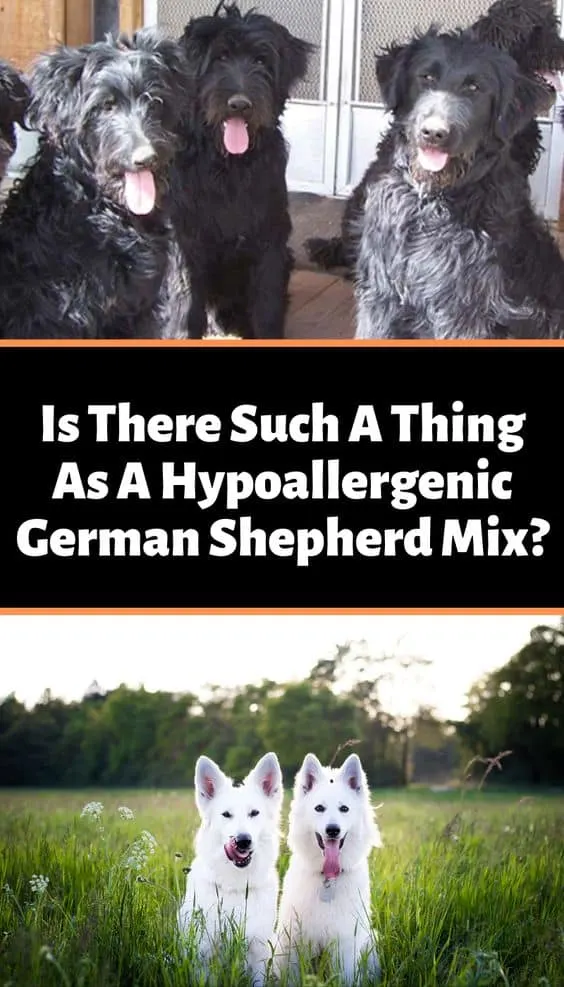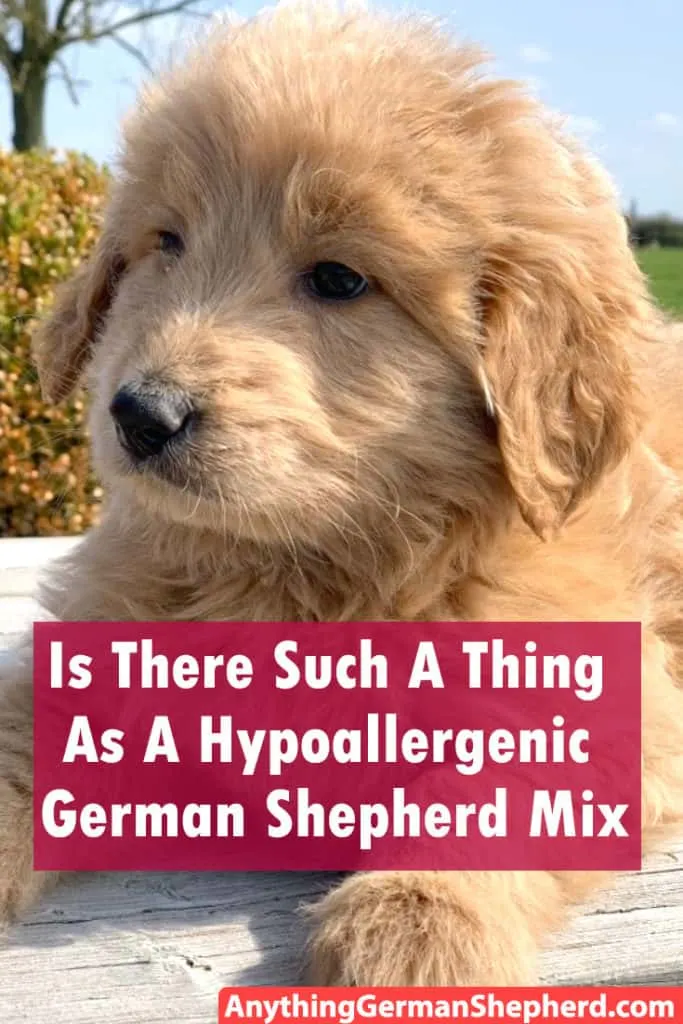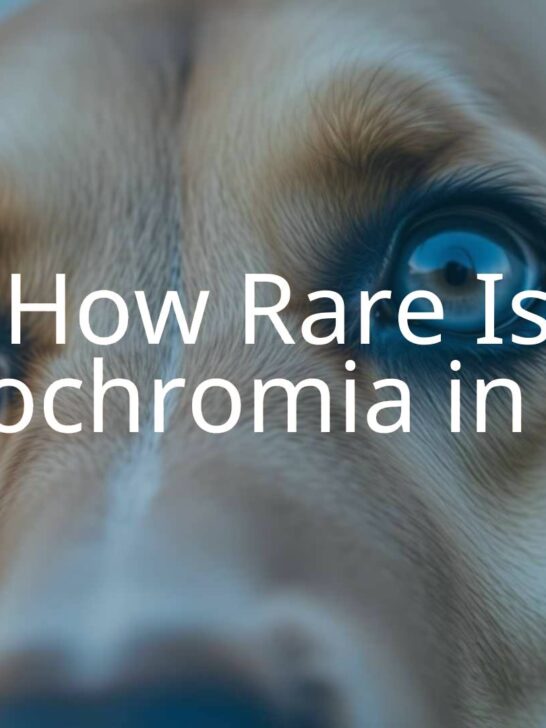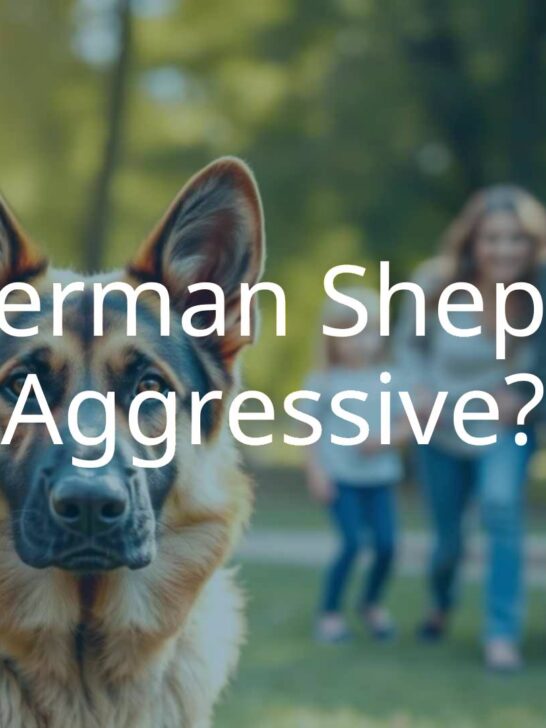Is There Such A Thing As A Hypoallergenic German Shepherd Mix?
Yes, but they don’t appear to be common, although German Shepherds are among the more common breeds.
What do people mean by a hypoallergenic dog?
The American Kennel Club or AKC defines a hypoallergenic dog as one having a non-shedding coat that produces little dander.
As all dogs have skin and produce dander, there is no such thing as a non-allergenic dog.
Dogs belonging to certain breeds, however, produce fewer allergens than others, and these dogs are described as hypoallergenic.
According to the staff writer on WebMD, both dog and cat allergies are caused by exposure to the animal’s dander, urine, and saliva.
The Allergy Center of Connecticut reports that proteins found in the dog’s urine, saliva, and skin are the cause of dog allergies.
Scientists have so far identified six proteins that cause allergic reactions: Can f 1, Can f 2, Can f 3, Can f 4, Can f 5, and Can f 6.
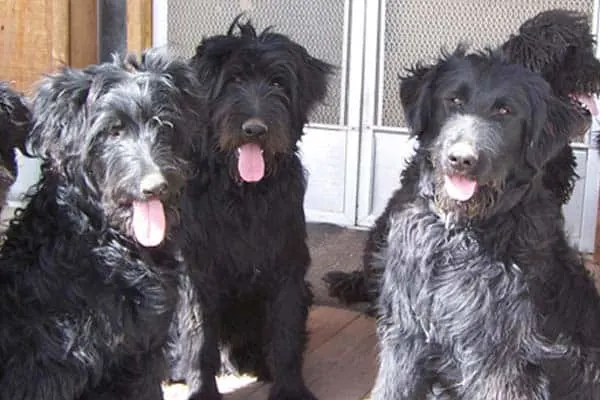
Are German Shepherds hypoallergenic?
Unfortunately, no. In fact, Dr. Melanie Grundy, a veterinarian who writes for “Central Pet Care,” lists German Shepherds as one of the worst breeds for people with dog allergies.
Other problematic breeds for people with allergies include the following:
- St Bernard
- Labrador Retriever
- Golden Retriever
- English Bulldog
- Boston Terrier
- Basset Hound
- Cocker Spaniel
Dogs belonging to these breeds either shed a lot, drool a lot or are susceptible to skin problems that increase the amount of dander they produce.
According to Nat Berman, a writer for PuppyToob,” German Shepherds made the list of “20 of the Worst Dog Breeds If You Have Allergies” because they produce more dander than many other breeds.
They also have a thick coat that sheds constantly throughout the year.
What dog breeds are hypoallergenic?
According to the AKC, hypoallergenic breeds include the following:
- Afghan Hound
- American Hairless Terrier
- Bedlington Terrier
- Bichon Frise
- Chinese Crested
- Irish Water Spaniel
- Maltese
- Poodle
- Portuguese Water Dog
- Schnauzer
- Xoloitzcuintli
These breeds shed less than others. Since dander is often attached to hair or fur, low-shedding dogs produce less dander and are thus less likely to trigger allergies.
It should be noted, however, that while the AKC recognizes over 200 dog breeds, they list only 26 breeds as hypoallergenic.
Some of these breeds, like the Poodle and the Yorkshire Terrier, are fairly common. Others, like the Bolognese or Affenpinscher, are comparatively rare.
Can mixes be hypoallergenic?
Mixes cross or hybrids are the results of crossing two purebred dog breeds to get the best traits of those breeds.
Many such mixes were created by crossing the hypoallergenic Poodle with another breed. The popular Labradoodle is an example of such a crossing.
Unfortunately, there is no guarantee that a particular Labradoodle will inherit its poodle parent’s hypoallergenic traits; it can just as easily be as allergenic as a Labrador Retriever.
How many German Shepherd mixes are there?
There are many German Shepherd mixes. German Shepherds are noted for their intelligence, loyalty, and urge to protect, so they are a popular parent breed for mixes.
The Dog Breed Info website provides a list of German Shepherd mixes. Unfortunately, many of them would be bad for people with allergies.
As already mentioned, German Shepherds tend to trigger allergic reactions in people. So do dogs like Labrador Retrievers and Golden Retrievers.
Crossing a German Shepherd with either of these would produce a mix that would be just as likely to cause allergies as either parent breed.
The only way to produce a hypoallergenic German Shepherd mix is to cross a German Shepherd with a hypoallergenic dog like a Poodle. In fact, such a dog does exist.
The Shepadoodle is a cross between a German Shepherd and a Standard Poodle, which is the largest of the three poodles. It is the best-known and most common hypoallergenic German Shepherd mix.
Other German Shepherd mixes that might be hypoallergenic include the Sheptese and the German Yorkie Shepherd.
The Sheptese is a cross between a German Shepherd and a Maltese, while the German Yorkie Shepherd is a cross between a German Shepherd and a Yorkshire Terrier.
Some of the other terriers are also hypoallergenic, so crossing them with a German Shepherd could produce a hypoallergenic German Shepherd mix.
Hypothetically, someone could also produce a hypoallergenic German Shepherd mix by crossing a German Shepherd with any of the other listed hypoallergenic dogs, such as the Giant Schnauzer or the Irish Water Spaniel.
What is the Shepadoodle like?
Shepadoodles are medium-sized to large dogs that can stand between 22 and 28 inches at the shoulder.
They typically weigh between 50 to 90 pounds, but some behemoths can weigh as much as 125 pounds. Their coats can be sable, gray, black, tan, or cream, and they have medium-length hair that is wavy or curly.
The PetGuide website includes more information about the Shepadoodle, which was developed by the US Army back in the 1960s as a police dog.
Both German Shepherds and Poodles originated as working breeds in Germany. While German Shepherds were bred to herd sheep, Poodles were used to help hunt waterfowl.
As a hypoallergenic German Shepherd mix, Shepadoodles were bred to have the intelligence of their parent breeds and the non-shedding coat of the Poodle.
Shepadoodles inherited a lot of intelligence from both parent breeds, and they can be used as service animals. They are also loyal and eager to please, so they can be easily trained.
Shepadoodles are energetic like both parent breeds and thus need a lot of exercise. Their alertness makes them good watchdogs, but it also means they can take time to warm up to unfamiliar people.
Shepadoodles are friendly and affectionate dogs that get along well with children and other pets. They even like cats.
While Shepadoodles are generally healthy, they can develop some of the genetic disorders seen in their parent breeds, like von Willebrand’s disorder and hip dysplasia.
The former is a type of hemophilia, which is a blood disease in which the blood does not clot properly. Shepadoodles are also prone to fleas and ticks if they aren’t properly groomed.
A healthy Shepadoodle typically lives 12 to 14 years.
The following video shows what Shepadoodles look like as puppies.
The next video is that of an older Shepadoodle undergoing training.
What kind of care does a Shepadoodle need?
Both Poodles and German Shepherds tend to have sensitive stomachs, so Shepadoodles need high-quality dog food.
It’s best to keep a puppy on the type of dog food used by the breeder before gradually switching to another brand. Adult Shepadoodles need three or four cups of dry dog food every day.
A Shepadoodle’s curly coat will require a lot of grooming, just like a Poodle’s. They need to be brushed every day to prevent tangles and mats, and they also need regular baths.
They should be given a buzz cut in the summer to let their skin breathe. A Shepadoodle should be given cod liver oil every day to keep their skin from getting too dry during winter or in cold environments.
Shepadoodles can grow quite large, so they should be socialized and trained from an early age. If the owner doesn’t know how to train a big dog, they should hire a trainer to help them.
Shepadoodles have strong pack instincts and thus respond well to somebody they see as the pack leader. They can do very well in agility and obedience training.
Shepadoodles need plenty of exercise to prevent obesity and keep them calm and happy. They thus need long walks, regular visits to dog parks, and lots of playtimes. They enjoy toys.
How can you tell that a German Shepherd mix is hypoallergenic?
According to Mike Clark, a writer for the Dog Time website, different coat types can affect how hypoallergenic a dog is.
First off, some dogs have fur while others have hair. The fur is denser and shorter than hair, and dogs with fur tend to shed more than dogs with hair. They thus spread more allergens than do dogs with hair.
Dogs with hair can have straight, wavy, or curly coats. Dogs with curly coats are generally among the better choices for people with allergies as their curls trap both dander and loose hair.
Any allergens produced by the dog stay near the dog and aren’t dispersed into the air. This is one reason booth Poodles and Shepadoodles tend to be hypoallergenic.
In the case of the Shepadoodle the “How to Train the Dog” website advises a prospective owner to examine the dog’s coat to make sure that this hypoallergenic German Shepherd mix really is hypoallergenic.
All Shepadoodles will shed less and produce less dander than German Shepherds. There will, however, be dogs with coats more like those of German Shepherds and others with coats more like those of poodles.
The dogs with the curly, Poodle-like coats will be the most hypoallergenic.














